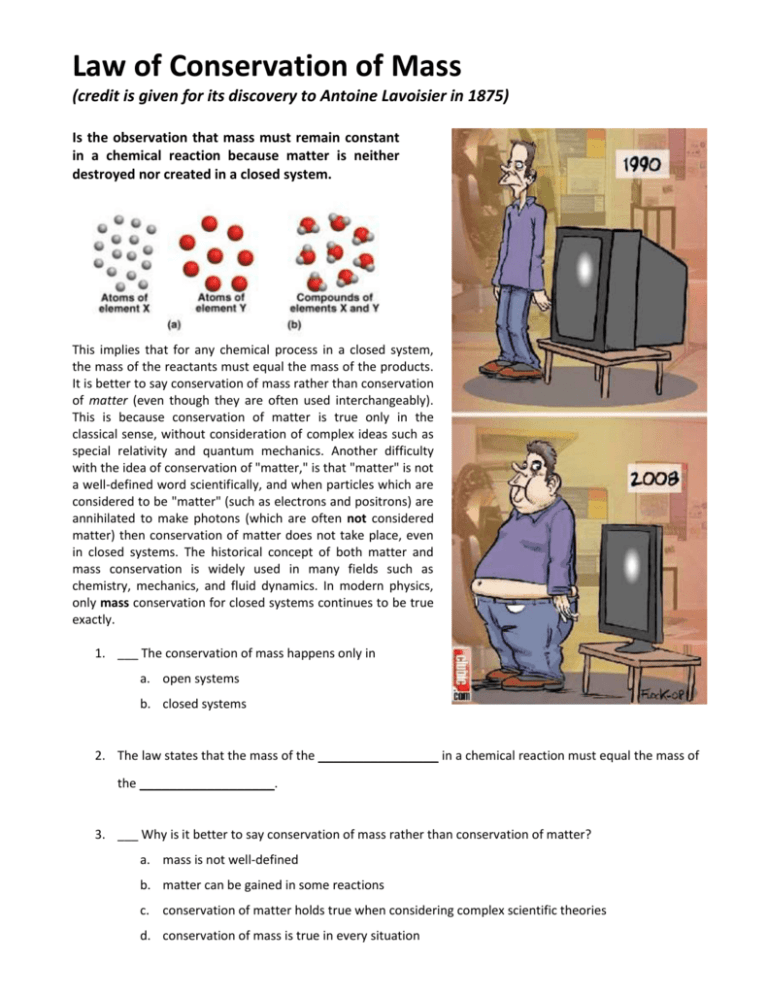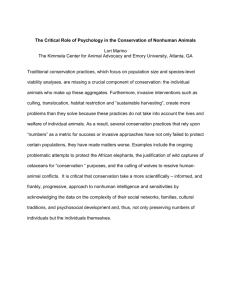information, demonstration and application
advertisement

Law of Conservation of Mass (credit is given for its discovery to Antoine Lavoisier in 1875) Is the observation that mass must remain constant in a chemical reaction because matter is neither destroyed nor created in a closed system. This implies that for any chemical process in a closed system, the mass of the reactants must equal the mass of the products. It is better to say conservation of mass rather than conservation of matter (even though they are often used interchangeably). This is because conservation of matter is true only in the classical sense, without consideration of complex ideas such as special relativity and quantum mechanics. Another difficulty with the idea of conservation of "matter," is that "matter" is not a well-defined word scientifically, and when particles which are considered to be "matter" (such as electrons and positrons) are annihilated to make photons (which are often not considered matter) then conservation of matter does not take place, even in closed systems. The historical concept of both matter and mass conservation is widely used in many fields such as chemistry, mechanics, and fluid dynamics. In modern physics, only mass conservation for closed systems continues to be true exactly. 1. ___ The conservation of mass happens only in a. open systems b. closed systems 2. The law states that the mass of the ________________ in a chemical reaction must equal the mass of the __________________. 3. ___ Why is it better to say conservation of mass rather than conservation of matter? a. mass is not well-defined b. matter can be gained in some reactions c. conservation of matter holds true when considering complex scientific theories d. conservation of mass is true in every situation Demonstration of the law… 1. Fill one cup halfway with vinegar. 2. Fill a second cup halfway with baking soda. 3. Put both cups in the plastic bag. Take care NOT to spill the contents of either cup. 4. Determine the mass of the cups and their contents, and the plastic bag. 5. Seal the plastic bag. 6. Without opening the bag, pour the vinegar into the cup of baking soda. 7. Without opening the bag, record the mass of the contents of the plastic bag. Take care not to break the seal of the plastic bag. a. Did a chemical reaction occur? How do you know? b. Was this an open system or a closed system? c. How did the mass change? Does this support the law of conservation of mass? Why or why not? 8. Open the bag to let out the gas. Mass the system. a. How did the mass change? b. This difference in mass suggests that: Do You Really Understand The Law of Conservation of Mass? Apply the law as you answer each of these questions. 1. ___ Two chemicals, A and B, react completely to yield products C and D. If 4 g of A and 8 g of B are reacted (with no excess of either), and 5 g of C are produced, how much D is produced? a. 3 g b. no D is produced c. 9 g d. 5 g e. 7 g 2. ___ When a 1-kilogram log was burned, 0.05 kilogram of ash was produced. The mass of the ash is less than the mass of the log because a. wind carried away some matter before it burned b. some matter was converted to gases that were released c. combustion changed some matter into energy d. some matter was decomposed by organisms in the soil 3. ___ When CaCO3 is heated, it forms CaO and CO2. Which of these statements best describes the mass of the products if 100 g of CaCO3 is heated? a. The difference in the products’ masses is equal to the mass of the CaCO3. b. The sum of the products’ masses is less than the mass of the CaCO3. c. The mass of each product is equal to the mass of the CaCO3. d. The sum of the products’ masses equals the mass of the CaCO3. 4. ___ The law of conservation of mass states that a. in a chemical reaction, mass is not created or destroyed, but is conserved b. mass can be created and destroyed but does not change forms c. in a chemical reaction, efforts should be made to preserve rare elements without changing them d. in a chemical reaction, the final mass of the products is always greater than the starting mass of the reactants 5. ___ If you heat 50 grams of wood in the absence of air and produce 10 g of ash, what is the total mass of the products? a. 50g b. 25g c. 10g d. 40g 6. ___ You place a piece of shiny aluminum that weighs exactly 1 gram into a container and seal it. The weight of the container and its contents is exactly 10 g. You allow it to sit for a week and then reweigh the container. After one week the weight of the container and its contents is still 10 g. The mass of the sample inside is now 1.5 g. What is the best explanation for this observation? a. The container had a leak because aluminum's mass increased. b. The mass of the aluminum atoms has increased. c. The aluminum reacted with some of the air inside the sealed container because the overall mass did not change. d. The mass has not really changed because it cannot change due to the Law of Conservation of Mass. 7. ___ When an iron nail rusts, it seems to get heavier in mass. Does the iron nail follow the Law of Conservation of Mass? a. No, rusting is an exception to the Law of Conservation of Mass. b. No, since rusting is a chemical change it does not follow the Law of Conservation of Mass. c. Yes, iron chemically combines with the oxygen in the air so if you add the oxygen into the mass of the chemicals before the reaction, the mass after the reaction is the same. 8. ___ Which of the following reactions best illustrates the Law of Conservation of Mass? a. H2O2 → H2O + O2 b. Na + CuS → Na2S + 2 Cu c. K + AgCl → KCl + Ag d. NaOH + 2 HCl → NaCl + H2O








